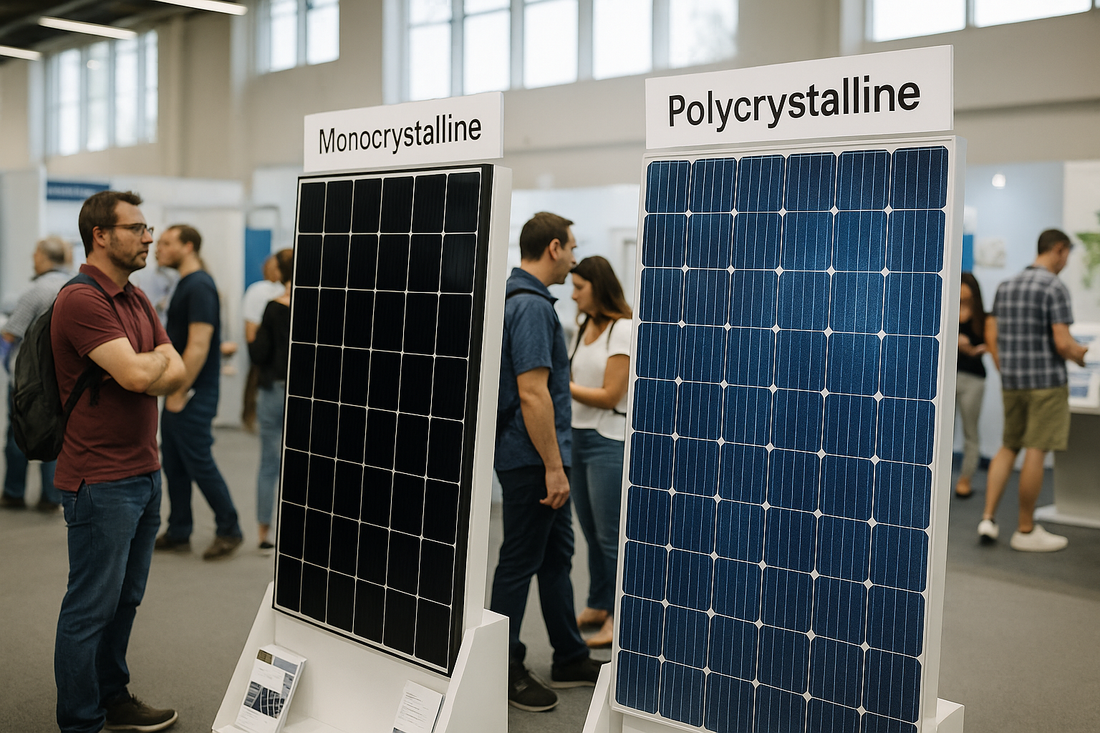
Monocrystalline vs Polycrystalline Solar Panel: Which is Best?
Share
Monocrystalline vs Polycrystalline: Key Differences
With the increasing demand for renewable energy sources, solar panels have become a cornerstone in the pursuit of sustainable power generation. As individuals and businesses strive to reduce their carbon footprints, the choice between monocrystalline Solar panels and polycrystalline solar panels has emerged as a significant decision in harnessing solar energy. This article aims to explore the differences between these two popular panel types, helping consumers make informed decisions about which solar panel option might be best suited for their needs.
Introduction to Solar Panels
What is a Solar Panel?
Solar panels are innovative devices designed to convert sunlight into electricity through the photovoltaic effect. At the core of this technology are solar cells, which capture sunlight and transform it into usable solar power. When sunlight hits the solar cells, they produce an electric current that can power homes, businesses, and entire communities. The solar cells made from silicon are grouped together to form solar panels, which can be installed on rooftops, open fields, or integrated into building structures to harness the sun's energy effectively.
Types of Solar Panels
There are several types of solar panels available on the market, each offering unique advantages. Among these, monocrystalline and polycrystalline solar panels are the most prevalent. Monocrystalline panels are known for their high efficiency rate and sleek appearance, whereas polycrystalline panels are often more cost-effective and have a distinct blue hue. Additionally, thin-film panels offer flexibility and lower costs but generally exhibit lower efficiencies. Homeowners typically choose from these three main types—monocrystalline, polycrystalline, and thin-film—depending on their specific needs and budget constraints.
Importance of Solar Energy
In the realm of renewable energy systems, solar panels play a pivotal role by providing a clean and sustainable source of power generation. Solar energy harnessed through these panels reduces dependency on fossil fuels, decreases greenhouse gas emissions, and promotes energy independence. As solar panel technologies advance, their adoption becomes increasingly critical in combating climate change and ensuring a sustainable future. By integrating solar panels into their energy mix, individuals and businesses can contribute to a greener planet while enjoying the benefits of reduced electricity bills and a more resilient energy system.
Monocrystalline Solar Panels
Definition and Characteristics
Monocrystalline solar panels, often referred to as mono panels, are a type of solar panel known for their high efficiency and sleek design. These panels are constructed from monocrystalline solar cells, which are made from a single, continuous crystal structure of silicon. This manufacturing process involves slicing silicon wafers from cylindrical silicon ingots, which gives these solar panels their characteristic uniform appearance and black hue. The mono cells exhibit a higher efficiency rate compared to other types of solar panels, making them a popular choice for both residential and commercial solar power systems. Their streamlined design and superior performance make them a leading option among various panel types.
Advantages of Monocrystalline Panels
One of the primary advantages of monocrystalline panels is their ability to achieve higher efficiencies, which is particularly beneficial when space is limited. These panels require less surface area to generate the same amount of electricity compared to polycrystalline panels, making them ideal for installations where space is at a premium. Additionally, monocrystalline solar panels perform well in low-light conditions, ensuring consistent energy production even on cloudy days. Although they come at a higher cost, the investment in monocrystalline panels often pays off in terms of long-term energy savings and increased property value, providing a sleek and efficient solution for solar energy generation.
Disadvantages of Monocrystalline Panels
The main disadvantage of monocrystalline panels lies in their cost. Monocrystalline solar panels are generally more expensive than their polycrystalline counterparts, with prices ranging from $1 to $1.50 per watt before installation. This is due to the more complex manufacturing process required to produce monocrystalline cells, which involves slicing silicon wafers from a single crystal. Additionally, the shaved pieces from this process are not reusable, further contributing to the higher expense. Despite these cost factors, many consumers find the superior performance and aesthetic appeal of monocrystalline panels to be worth the investment, particularly when efficiency is a top priority.
Polycrystalline Solar Panels
Definition and Characteristics
Polycrystalline solar panels, commonly referred to as poly panels, are a type of solar panel that utilizes polycrystalline solar cells. These cells are composed of multiple silicon crystals, giving them a distinctive blue hue and a less uniform appearance compared to monocrystalline solar panels. The manufacturing process for polycrystalline panels is simpler and involves melting raw silicon and pouring it into a square mold, which is then cooled and cut into wafers. This method results in a lower cost production compared to monocrystalline cells, making polycrystalline panels a popular choice for those seeking a cost-effective solar panel option.
Advantages of Polycrystalline Panels
One of the most significant advantages of polycrystalline solar panels is their affordability. With costs ranging from 90 cents to $1 per watt before installation, they are a more budget-friendly option compared to monocrystalline panels. This makes polycrystalline panels particularly appealing to consumers who aim to minimize upfront solar panel installation costs. While they may require a larger area to achieve the same kilowatt-hour output due to lower efficiency rates, polycrystalline panels are ideal for situations where space is not a restriction. Their cost-effectiveness makes them an attractive choice for budget-conscious consumers and those looking to reduce initial expenses while still benefiting from solar energy.
Disadvantages of Polycrystalline Panels
Despite their lower cost, polycrystalline solar panels do have some drawbacks, primarily concerning efficiency. Polycrystalline panels typically exhibit lower efficiencies, ranging from 15% to 17%, due to the presence of multiple crystals within each solar cell. This structure limits the movement of electrons, resulting in reduced energy conversion rates compared to monocrystalline panels. Additionally, polycrystalline panels may perform less effectively in high-temperature conditions. However, they still deliver a reliable lifespan, often extending beyond 20 years, making them a viable option for many solar power systems despite their lower efficiency rate and performance limitations in heat.
Monocrystalline vs Polycrystalline: Key Comparisons
Efficiency and Performance
When it comes to efficiency and performance, monocrystalline solar panels generally have the upper hand in the monocrystalline vs polycrystalline comparison. Monocrystalline panels, constructed from monocrystalline solar cells, typically demonstrate higher efficiencies, ranging from 17% to 22%, making them the most efficient solar panel option for residential installations. In contrast, polycrystalline solar panels, with efficiency rates between 15% to 17%, offer slightly lower performance. This disparity is largely due to the structure of the solar cells made from silicon, where monocrystalline cells allow for better electron flow. While poly panels are less efficient, they are often chosen for their cost-effectiveness, especially in installations where space is ample, and the highest efficiency is not paramount.
Cost Comparison
Cost is a significant factor in the decision-making process between monocrystalline and polycrystalline solar panels. Monocrystalline panels are known for their higher efficiency but come with a higher price tag, costing between $1 to $1.50 per watt before installation. This is due to the more complex manufacturing process of monocrystalline cells. On the other hand, polycrystalline panels are more affordable, with prices ranging from 90 cents to $1 per watt. The cost difference is mainly attributed to the silicon structure, where polycrystalline panels utilize a simpler production method. Therefore, while monocrystalline panels offer better performance, polycrystalline panels present a more budget-friendly option for those willing to sacrifice a bit of efficiency for lower upfront costs.
Longevity and Warranty
Both monocrystalline and polycrystalline solar panels are renowned for their durability and long lifespans, often extending well beyond 20 years. Monocrystalline panels, which are sometimes preferred for their all-black appearance, typically come with a warranty of around 25 years. This extended warranty reflects their long-term reliability and the confidence solar panel manufacturers have in their performance over time. Polycrystalline panels may perform slightly worse in high heat conditions but still offer a dependable lifespan, usually accompanied by a similar warranty period. Therefore, regardless of whether you choose mono or poly solar panels, you can expect a robust lifespan that ensures continued solar power generation for decades.
Choosing the Best Solar Panel
Factors to Consider
When selecting the best type of solar panel for your needs, various factors must be taken into account. First, consider the available space and how the panel sizes fit within it. Monocrystalline panels may be preferred when space is limited due to their higher efficiencies. Budget is another crucial consideration, as monocrystalline solar panels generally require a higher initial investment compared to polycrystalline options. Additionally, take into account the aesthetic appeal, with monocrystalline panels offering a sleek black appearance and polycrystalline panels a blue hue. Finally, evaluate the warranties offered by solar companies, ensuring you select a solar equipment option that aligns with your long-term energy production goals and financial considerations.
Best Applications for Each Type
The best applications for monocrystalline and polycrystalline solar panels depend largely on the specific needs and constraints of the installation site. Monocrystalline panels, known for their high efficiency and uniform black look, are ideal for residential settings where space is limited, and maximum efficiency is desired. They also perform well in low-light conditions, making them suitable for areas with variable weather. Conversely, polycrystalline panels are a more cost-effective choice for large-scale commercial buildings with ample roof space, where a slightly lower efficiency rate is acceptable. Their affordability makes them a practical solution for projects where budget constraints are a priority over top-tier efficiency.
Conclusion: Which is Right for You?
Deciding between monocrystalline and polycrystalline solar panels requires careful consideration of several factors, including budget, efficiency needs, and available installation space. Monocrystalline panels are often favored for their higher efficiency rates, making them well-suited for residential applications where space and performance are key priorities. They generally provide greater long-term savings, despite the higher upfront cost. Meanwhile, polycrystalline panels offer a more economical choice for those with budget constraints, particularly in larger installations. Ultimately, the decision should be based on individual preferences, financial capacity, and specific requirements, ensuring the selected solar panel type aligns with your solar system goals.
